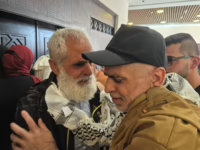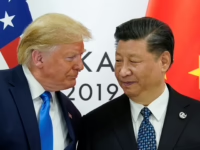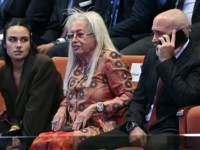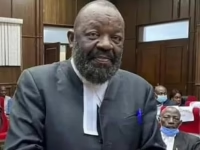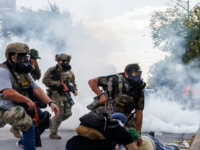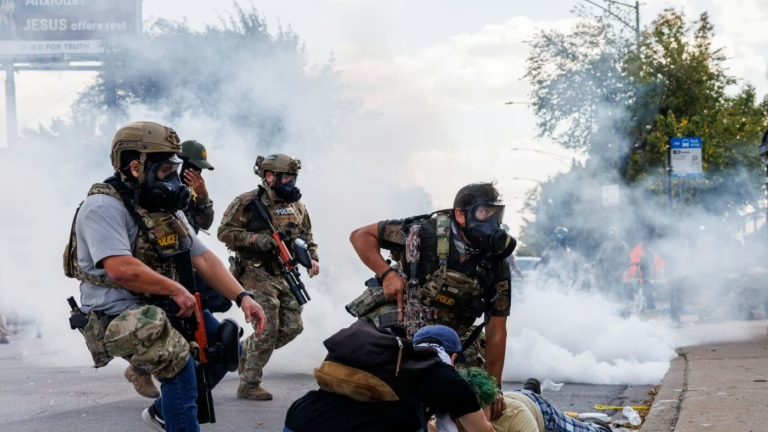Federal agents detain an individual as community members and activists demonstrate near the 3900 block of South Kedzie Avenue, Chicago, on October 4.
Armando L. Sanchez/Tribune News Service
hide caption
toggle caption
Armando L. Sanchez/Tribune News Service
Numerous clips circulating on social media depict similar distressing encounters. One such video, captured by a photographer in Hyattsville, Maryland, shows a man restrained on the ground by two ICE officers. The individual urgently calls out for assistance in both Spanish and English.
During this confrontation, an officer accidentally drops his firearm and struggles to retrieve it, subsequently appearing to aim it toward nearby onlookers. Emily Covington, assistant director of ICE’s Office of Public Affairs, explained to NPR that brandishing a weapon can sometimes serve as a method to de-escalate tense situations.
In another incident near Chicago, specifically in Broadview, Illinois, footage reveals a man outside an ICE facility being struck in the head with a pepper ball-a projectile containing chemical irritants. This man, Pastor David Black, has since filed a lawsuit against the Trump administration.
Adding to the concerns, a local CBS journalist reported that a masked ICE agent fired a pepper ball at her vehicle at the same Broadview location, causing her to suffer prolonged nausea. Reporter Asal Rezaei noted that no protests were occurring at the time. The Broadview Police Department has launched an investigation into the matter.
Fred Tsao, senior policy counsel at the Illinois Coalition for Immigrant and Refugee Rights, remarks, “These incidents represent only a fraction of what’s happening. We’ve witnessed people being tackled, subjected to pepper spray and tear gas, threatened, and at least two cases involving gunfire.”
Despite widespread public disapproval of the Trump administration’s immigration enforcement methods-as highlighted in a recent survey by The New York Times and Siena University-advocates in Chicago report that federal immigration agents are intensifying their aggressive tactics.
“The current administration appears more focused on escalating conflicts rather than calming them,” Tsao adds.
In late September, federal agents conducted a large-scale raid on an apartment complex on Chicago’s south side, forcibly entering units and detaining dozens of individuals.
Earlier this month, federal officers shot a woman in Chicago, and weeks prior, fatally shot a man in a nearby suburb. Department of Homeland Security officials claimed both victims posed threats to officers. However, body camera footage from the fatal shooting shows the responding officer describing his injuries as “nothing major.”
Regarding the woman’s case, her attorney asserts that body camera evidence contradicts the official account. Recently, a grand jury indicted her and another individual, accusing them of obstructing and intimidating federal officers during their duties.
Ed Yohnka, communications and public policy director at the ACLU of Illinois, which has filed a lawsuit against the Trump administration for infringing on protesters’ constitutional rights, states, “We are witnessing a troubling rise in violent behavior and excessive force by ICE agents.”
In response, Emily Covington emphasized that ICE officers receive extensive training and operate within legal and policy frameworks. She also cited a significant increase in assaults against ICE personnel, though reports from Colorado Public Radio suggest these claims may be exaggerated.
Gil Kerlikowske, former commissioner of U.S. Customs and Border Protection under the Obama administration and former police chief in Seattle and Buffalo, critiques the preparedness of federal immigration agents for urban policing.
“They lack the necessary training, skills, and experience to effectively police city environments,” Kerlikowske explains.
He stresses that effective urban law enforcement depends on de-escalation, building trust, and community cooperation. The aggressive tactics employed by federal agents in Chicago and other cities, he argues, are unwarranted.
“These strategies are unnecessary for accomplishing their objectives,” Kerlikowske concludes. “I find this deeply disappointing.”
Judicial rulings have established that any use of force by law enforcement-whether local, state, or federal-must be “objectively reasonable.”
Seth Stoughton, a law professor at the University of South Carolina who trains police officers, clarifies, “The phrase ‘objectively reasonable’ requires context to have meaning.”
The Department of Homeland Security, which oversees ICE, adheres to this standard. Its latest use-of-force policy mandates that officers employ force only when “no reasonably effective, safe, and feasible alternative exists,” emphasizing principles such as “de-escalation” and “respect for human life.”
For force to be constitutionally justified, a legitimate threat must be present. Threats can vary widely-from armed individuals to those resisting arrest-and law enforcement responses must be proportionate to the level of danger.
“We evaluate situations from the perspective of a reasonable officer on the scene,” Stoughton explains. “It might be appropriate for an officer to approach someone and say, ‘Stop, I need to speak with you.’ But it would be unreasonable to point a gun at that person and threaten to shoot.”
While many uses of force may be legally defensible, Stoughton cautions that legality does not always equate to appropriateness.
“Most people aren’t just asking if an action complies with the Fourth Amendment,” he says, referring to protections against unreasonable searches and seizures. “They’re questioning whether the police conduct is socially and democratically acceptable, which is a different matter entirely.”
Immigrant advocacy organizations in Chicago, including the ACLU of Illinois, accuse federal agents of breaching legal boundaries by employing “violent force” against protesters and others.
Consequently, these groups stress the importance of bystanders recording such encounters, as documentation helps clarify disputes over the legitimacy of force used.







